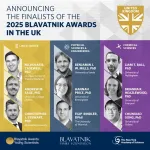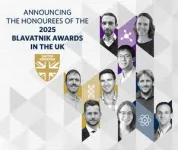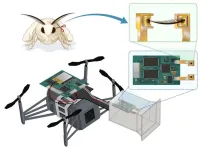19 February 2025 – London – The Blavatnik Family Foundation and The New York Academy of Sciences today announced the Finalists for the eighth Blavatnik Awards for Young Scientists in the United Kingdom. The Awards recognise scientific advances by UK researchers across Life Sciences, Chemical Sciences, and Physical Sciences & Engineering.
On Wednesday, 4 March, Professor Shitij Kapur, FMedSci, Vice-Chancellor & President, King’s College London, will announce the three 2025 Laureates at a gala dinner and awards ceremony. The three Laureates will each receive an unrestricted award of £100,000 (US$126,000). . The remaining six Finalists will each receive £30,000 (US$37,800).
This year’s Finalists were selected by an independent jury of expert scientists from a pool of 94 nominees representing 45 academic and research institutions across the UK. They include:
Life Sciences Finalists
Nicholas R. Casewell, PhD - Liverpool School of Tropical Medicine – a toxinologist, uses molecular and biochemical approaches to understand variations in snake venom toxins to identify new treatment strategies for snakebite envenoming, a neglected tropical disease.
Andrew M. Saxe, PhD - University College London – a neuroscientist, has developed mathematical analyses illuminating learning mechanisms in artificial and biological systems, advancing AI understanding and insights into memory-related neurological diseases.
Christopher Stewart, PhD - Newcastle University – a microbiologist, has developed novel microbiome-based approaches to prevent necrotising enterocolitis (NEC), the leading cause of death in preterm infants around the world.
Chemical Sciences Finalists
Liam T. Ball, PhD - University of Nottingham – an organic chemist, is developing efficient methods for the safe and sustainable synthesis of molecules vital to healthcare and agriculture.
Brianna R. Heazlewood, PhD - University of Liverpool – a physical chemist, has developed instruments that characterise complex chemical reactions at extremely cold temperatures, providing new insights into the chemistry of space and other challenging environments.
Chunxiao Song, PhD - University of Oxford – a chemical biologist, is developing a state-of-the-art sequencing method to detect DNA and RNA modifications, enabling early cancer detection and leading to the founding of a $410 million biotech company.
Physical Sciences & Engineering Finalists
Benjamin J.W. Mills, PhD - University of Leeds – a biogeochemist, is developing long-timescale models of the Earth, linking geology and biology and giving insight into our planet's connected atmospheric and geologic history, co-evolution of life and the Earth, the future of our planet, and the habitability of other worlds.
Hannah Price, PhD, University of Birmingham – a theoretical physicist, has authored groundbreaking theories and innovative experimental collaborations employing synthetic analogues to simulate higher dimensions, giving insight into physics with more than three spatial dimensions, including the fourth dimension.
Filip Rindler, DPhil – The University of Warwick – a mathematician, has developed the first rigorous theory describing how crystalline materials, like metals, deform through microscopic defects called dislocations. This theory advances foundational mathematics and opens new research avenues in materials science.
This is the first year the Blavatnik Awards Finalists include researchers from Newcastle University, the University of Liverpool, and the Liverpool School of Tropical Medicine.
The Blavatnik Awards for Young Scientists are the largest unrestricted prizes available to UK scientists aged 42 or younger. Since launching in 2017, UK scientists honoured by the Blavatnik Awards have received more than £3 million (US $3.8 million) in prize money. Internationally recognised by the scientific community, the Blavatnik Awards for Young Scientists are instrumental in expanding the engagement and recognition of young scientists and providing the support and encouragement needed to drive scientific innovation for the next generation.
The Blavatnik Awards in the UK sit alongside their global counterparts, the Blavatnik National Awards and the Blavatnik Regional Awards in the United States, and the Blavatnik Awards in Israel, all of which honour and support exceptional early-career scientists. By the close of 2025, the Blavatnik Awards will have awarded prizes totalling nearly $20 million.
“We created the Blavatnik Awards to support the creative and novel research of promising scientists early in their careers, recognising their achievements and accelerating the trajectories of beneficial scientific breakthroughs and innovations,” said Sir Leonard Blavatnik, Founder of Access Industries and Head of the Blavatnik Family Foundation.
Professor Nicholas B. Dirks, President and CEO of The New York Academy of Sciences and Chair of the Awards’ Scientific Advisory Council, noted, “I wish these nine Finalists a hearty congratulations and best of luck. They demonstrate great promise and potential through their bold, scientific research. Their work lays the foundation for treatments and discoveries that can help people, our planet, and the pursuit of science itself.”
Blavatnik Awards scholars are driving economic growth by embarking on new scientific trajectories to pursue high-risk, high-reward scientific research. To date, Blavatnik Awards honourees have founded 74 companies. After recognition by the Blavatnik Awards, 30% of past honourees obtained a patent or filed a patent application, 75% have started a new research direction, and 11% have started a new collaboration with another Blavatnik Awards honouree.
Members of the public interested in learning more about the research of this year’s honourees may register to attend a free public symposium entitled “Imagining the Impossible: UK Scientists Changing Our World,” at the Royal Academy of Medicine on 5 March 2025 from 11:00 to 16:00 GMT.
To attend this FREE public symposium, register HERE.
– ENDS –
About the Blavatnik Awards for Young Scientists
The Blavatnik Awards for Young Scientists, established by the Blavatnik Family Foundation in 2007 and independently administered by The New York Academy of Sciences, began by identifying outstanding scientific talent in New York, New Jersey, and Connecticut. In 2014, the Blavatnik National Awards were created to recognise faculty-rank scientists throughout the United States. In 2017, the Awards were further expanded to honour faculty-rank scientists in the UK and Israel. For updates about the Blavatnik Awards for Young Scientists, please visit www.blavatnikawards.org or follow us on X and Facebook @BlavatnikAwards.
About the Blavatnik Family Foundation
The Blavatnik Family Foundation provides many of the world’s best researchers, scientists, and future leaders with the support and funding needed to solve humankind’s greatest challenges. Led by Sir Leonard Blavatnik, founder and chairman of Access Industries, the Foundation advances and promotes innovation, discovery, and creativity to benefit the whole of society. Over the past decade, the Foundation has contributed over US$1 billion to more than 250 organisations. See more at www.blavatnikfoundation.org.
About The New York Academy of Sciences
The New York Academy of Sciences is an independent, not-for-profit organisation that, since 1817, has been committed to advancing science for the benefit of society. With more than 20,000 Members in 100 countries, the Academy advances scientific and technical knowledge, addresses global challenges with science-based solutions, and sponsors a wide variety of educational initiatives at all levels for STEM and STEM-related fields. The Academy hosts programs and publishes content in the areas of life and physical sciences, the social sciences, nutrition, artificial intelligence, computer science, and sustainability. The Academy also provides professional and educational resources for researchers across all phases of their careers. The Blavatnik Awards for Young Scientists is part of a series of prominent awards and scholarship programs that the Academy and its partners present each year to accomplished early-career and established scientists worldwide. These initiatives, along with education and professional development programs for students and young scientists, reflect the Academy’s broader commitment to strengthening and diversifying the pipeline for skilled and talented scientists globally. Please visit us online at nyas.org.
END



